GNOME 2.20 Release Notes
1. Introduction
GNOME 2.20 is the latest version of the GNOME Desktop: a popular, multi-platform desktop environment. GNOME's focus is ease of use, stability, and first class internationalization and accessibility support. Based on Free and Open Source Software, GNOME provides all of the common tools computer users expect of a modern computing environment, as well as a flexible and powerful platform for software developers.
The improvements in GNOME 2.20 include: Improved support for right-to-left languages; desktop search integrated into the file chooser dialog; convenient new features in the Evolution email and calendar client; enhanced browsing of image collections; simplified system preferences; efficient power management and incredibly accurate laptop battery monitoring. Developers receive more help with application development thanks to a new version of the GTK+ toolkit, improved tools, and a great new documentation web site.
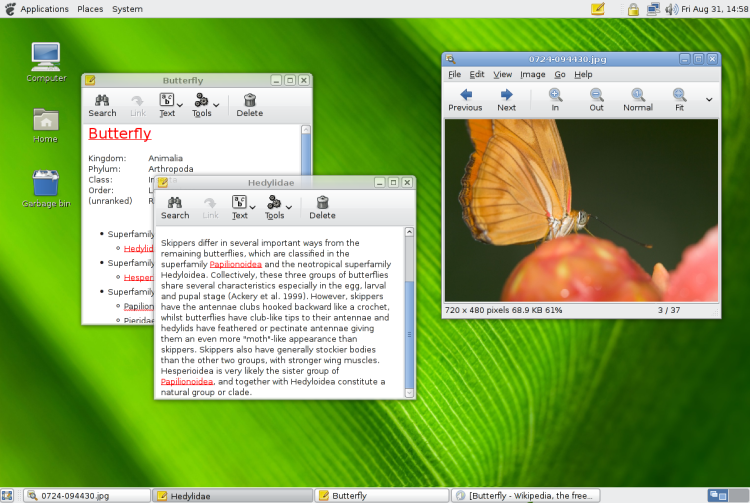
The GNOME Desktop is released every six months with many new features, improvements, "bug" fixes and translations, and GNOME 2.20 continues this tradition. To learn more about GNOME and the qualities that distinguish it from other computer desktop environments (like usability, accessibility, internationalization and freedom) visit the About GNOME page on our website.
Придружите нам се већ данас и помозите да побољшамо ствари.
GNOME 2.20 includes all of the improvements made in GNOME 2.18 and earlier. You can learn more about the changes that happened in GNOME 2.18 from its release notes.
These 2.20 release notes are available in several languages: Albanian, Arabic, Bulgarian, Catalan, Chinese (Simplified), Chinese (Traditional), Danish, Dutch, Estonian, English, French, German, Greek, Indonesian, Italian, Japanese, Korean, Lithuanian, Macedonian, Punjabi, Polish, Portuguese (Brazilian), Russian, Serbian, Serbian (Latin), Spanish, Swedish, Thai, Turkish, Ukranian, Vietnamese, Welsh.
2. Шта је ново за кориснике
The GNOME Project's focus on users and usability continues in GNOME 2.20 with its hundreds of bug fixes and user-requested improvements. The sheer number of enhancements make it impossible to list every change and improvement made but we hope to highlight some of the more exciting user-oriented features in this release of GNOME.
- 2.1. Email and Calendar
- 2.2. Web Browser
- 2.3. Image Viewing
- 2.4. Document Viewer
- 2.5. Sound and Video
- 2.6. Note-Taking
- 2.7. Text Editing
- 2.8. File Management
- 2.9. Panel
- 2.10. Control Panel
- 2.11. Password Management
- 2.12. Help System
- 2.13. Power Management
- 2.14. Login and Screensaver
- 2.15. Right-To-Left Languages
- 2.16. Accessibility
2.1. Email and Calendar
GNOME's email and groupware client, Evolution, has several new features.
The new attachment warning could mean the end of those "Sorry, I forgot to attach the file" emails. If you try to send an email that contains the word "attachment" (or similar words), but don't actually attach a file, you will see a helpful warning.
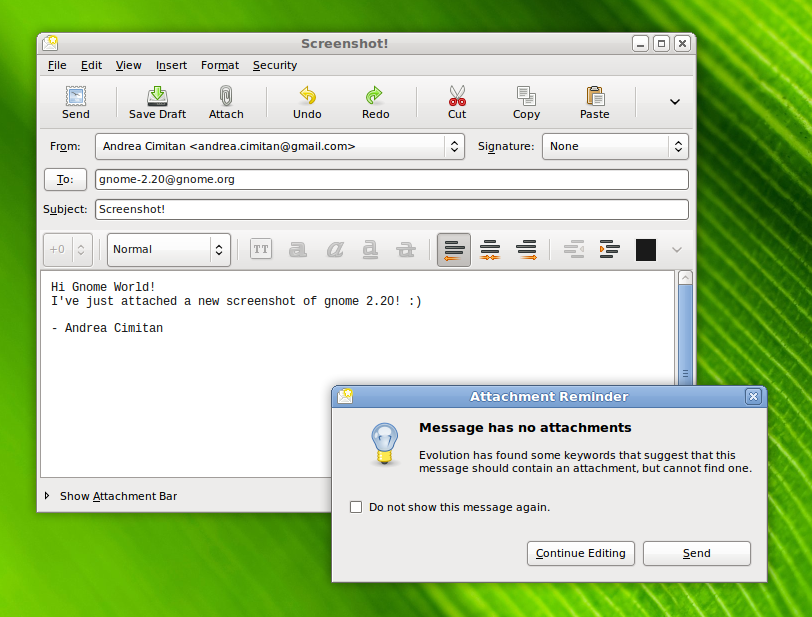
Evolution now shows an icon in your panel's notification area when you have new email. Note that, because this is currently only a plugin which is not yet fully integrated into the main preferences, you need to disable the plugin itself if you would like to disable this feature.

Moving your configuration and Email archive to a new computer is now much easier thanks to the new Backup/Restore feature.
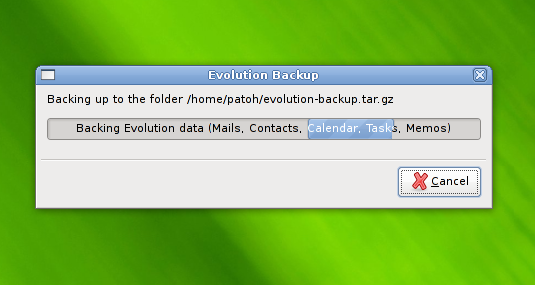
The new "Magic Space Bar" support is hard to find, but useful - it means you need just one key to read new mails in all your folders. Just press the space bar to scroll the message preview window to the end of the email, then press it again to view the next unread email in that folder. When you've read all the emails in that folder, press it again to show the first unread email in the next folder.
Evolution's calendar feature also has some useful improvements. The search interface allows advanced searches such as those already available for email and address book searches, and you can save your searches to run them again later. The Show drop-down now provides quick access to the next 7 day's appointments and to active appointments.
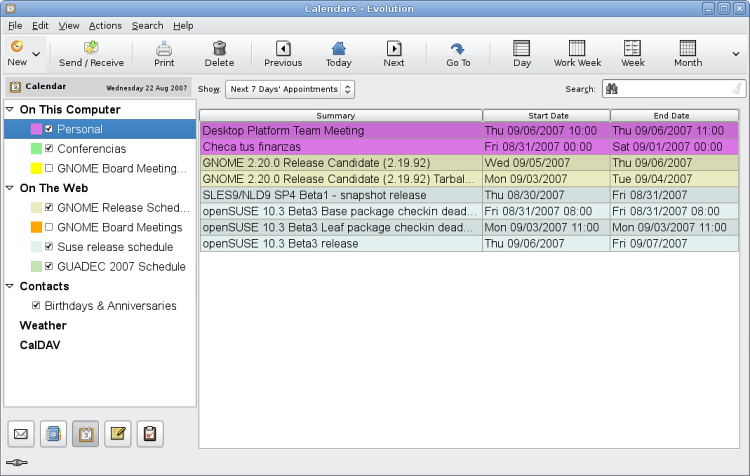
In addition, the Email client now
- moves threads to the top of the list when a thread has a new Email, when using the threaded view.
- uses the standard GTK+ printing system, using the same dialog windows as other applications, while providing more printing options than before.
- allows you to choose the Spam plugin (SpamAssassin or BogoFilter) via its preferences. And SpamAssassin will now actually learn when you mark emails as Junk or Not Junk.
Users of Microsoft Exchange will welcome improvements to Evolution's Exchange support, which include:
- Access to Exchange's delegation feature so that a colleague can handle your work while you are away.
- Faster use when offline.
- Faster loading of folders.
2.2. Web Browser
GNOME's integrated web browser, Epiphany, has been subtly but significantly improved.
For instance, inline completion in the address bar is now more intuitive. When you use the cursor keys to select from the drop-down list, the current selection is shown immediately in the entry box, so it's easier to see what address will be used when you press enter. This drop-down menu lists addresses from both your history and bookmarks, and it now shows the web site icons (favicons) for history items, as it already did for bookmark items.
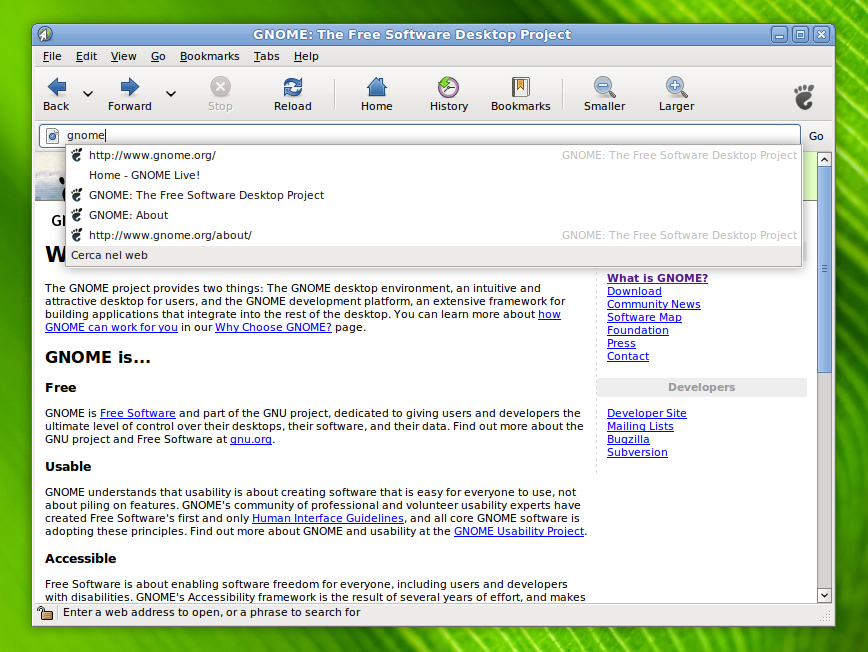
By popular request, there's a new "smooth scrolling" preference that makes it easier to see where to continue reading when scrolling large web pages. It is not enabled by default because several users have reported that it can cause eye strain.
2.3. Image Viewing
GNOME's image viewer, eog, is now faster and more stable. The new image properties dialog provides easy access to basic information and metadata for your images, and now includes XMP (Extensible Metadata Platform) data that your camera or software might store in your image files, along with the existing EXIF data. This might include location, copyright information, license, and tags.
And you can now easily open an image in another application, such as the GIMP, by using the new "Open with..." menu item. When you've made your changes and saved the file then your picture will be updated in the image viewer automatically. This is also available in the new right-click menu in the image collection pane, at the bottom of the window, along with other useful actions. That image collection now has large vertical buttons at the left and right, making it easier to browse through your pictures.
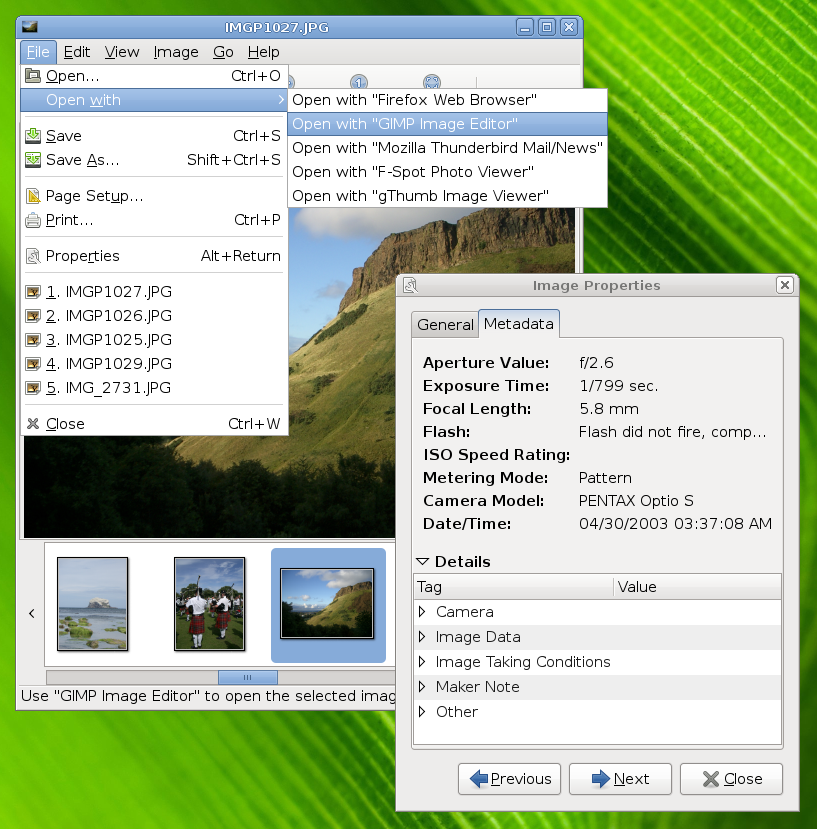
2.4. Document Viewer
GNOME's Evince viewer, for PDF and Postscript files now supports interactive PDF forms, allowing you to enter information into a PDF that you receive, to save or print. Page rendering is the new version is now noticeably faster.
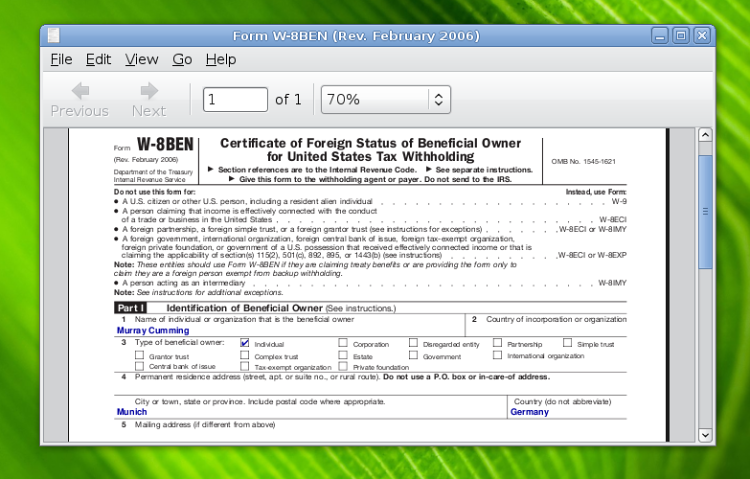
You can also now save images from PDF documents and print documents with multiple PDF pages per sheet.
2.5. Sound and Video
Not all distributions like to install all multimedia codecs by default, due to the need to obtain patent licenses for some codecs in some countries. This means that applications can not always read every file format by default. But applications such as GNOME's video player, Totem, can now offer these new codecs to the user for installation. This is actually implemented by your distribution, which may make its own decisions about how to obtain the codecs. Here's how it looks in Ubuntu:
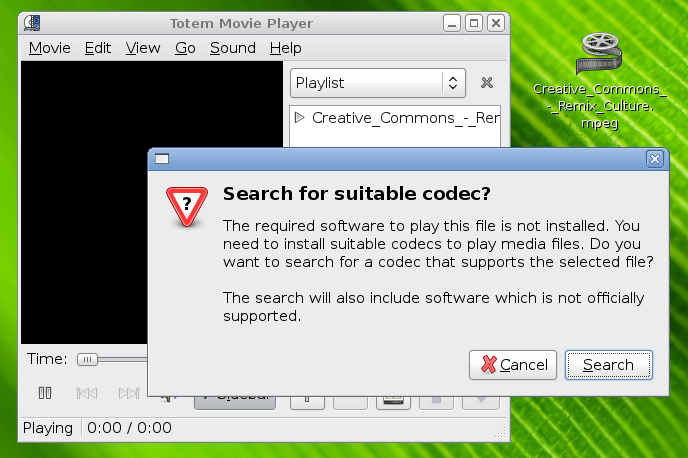
Totem's support for embedded videos in web pages has also improved, supporting more web pages, showing a pulsing play button when you need to press play to start the video, and now allowing you to go into full-screen mode from the web page.
2.6. Note-Taking
Tomboy, the GNOME note taking application, has also added some significant new features, the first of which is note synchronization. Tomboy can now use WebDAV or ssh to connect to a remote server and synchronize all the notes that a user has made. This allows for users who use multiple computers to keep one set of synchronized notes between all the machines. Simple conflict resolution between the server and the Tomboy clients ensures that there is no data loss in case of a note conflict.
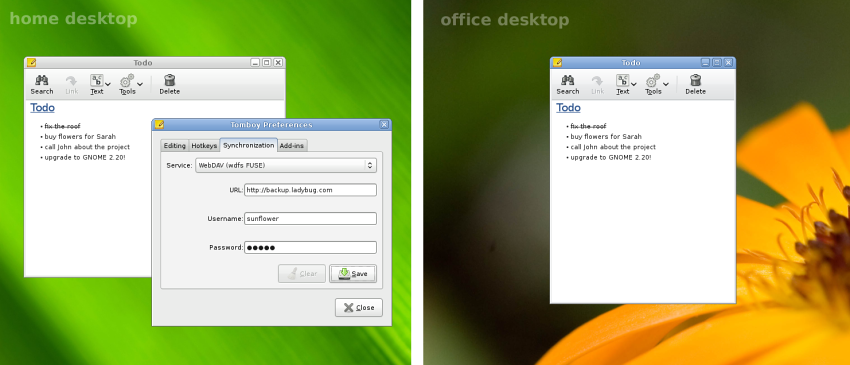
Furthermore, Tomboy now remembers your open notes, showing them again when you restart the application.
2.7. Text Editing
GNOME's simple but powerful text editor, gedit, has an all-new syntax-highlighting system which now supports syntax highlighting for scripting languages such as PHP and Ruby even when embedded in HTML, as well as highlighting of text such as "TODO" or "FIXME" inside code comments, and highlighting of gtk-doc source code documentation.
You can even choose from several color schemes in case you are already familiar with the colors used by a different text editor.

2.8. File Management
The file chooser dialog now shows the recent files list and can use desktop search systems such as Beagle or Tracker, making it easier to find your files when you need them, without interruption.

The Nautilus file manager now shows more information in the "Properties" window for drives, including a pie graph that easily shows how much space is left. In addition, you can now see the overall disk usage in the Disk Usage Analyzer utility.

(Observant users will notice the bug with the type, size, and mime type information in that screenshot. We hope to have that fixed for GNOME 2.22.)
The file manager also now uses the EXIF camera information in some image files to rotate its thumbnails when appropriate. This means that, when you take a picture with your camera and import it into GNOME, the orientation of the thumbnail will be correct, whether it was taken as landscape or portrait.
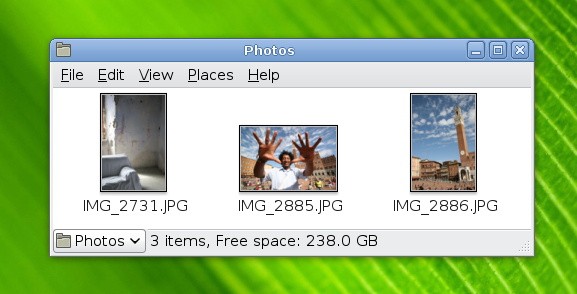
The file-roller archive manager can now open and save archives from networked locations, such as mounted ssh:// servers, by using the same gnome-vfs system that is already used by other GNOME applications. It is also now possible to copy/paste and drag-and-drop files between archives.
2.9. Panel
The GNOME Panel can be seen at the top and bottom of your screen in most distributions. It has some small but helpful improvements in GNOME 2.20. For instance, the Window List applet no longer resizes its buttons whenever the length of window titles change. This avoids annoying resizes when changing tabs in your web browser. And the Window Selector applet now sorts its drop-down list by workspace.
Users of "floating panels" (which don't expand to fill the whole screen width) might notice that these panels now remain in the correct position and alignment when changing screen resolution. More work to improve the repositioning of panel applets when changing screen resolution is planned for GNOME 2.22.
2.10. Control Panel
For GNOME 2.20, the control panels have been reorganized slightly to reduce the number of control panels, making it easier to find what you need.
For instance, this release marks the debut of the new Appearance control panel applet. The Theme, Background, Fonts, and Interface applets have been merged to create this new applet, simplifying the Preferences menu.
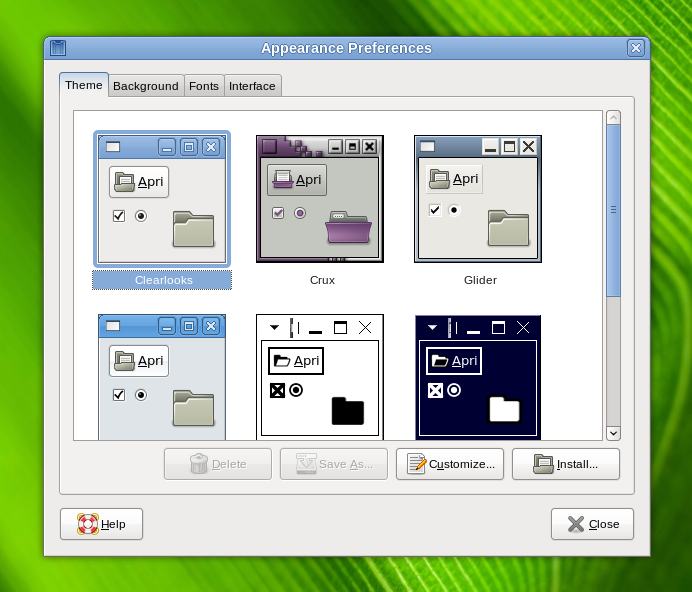
In addition, some of the Accessibility preferences have been moved to a new tab in the Preferred Applications control panel.
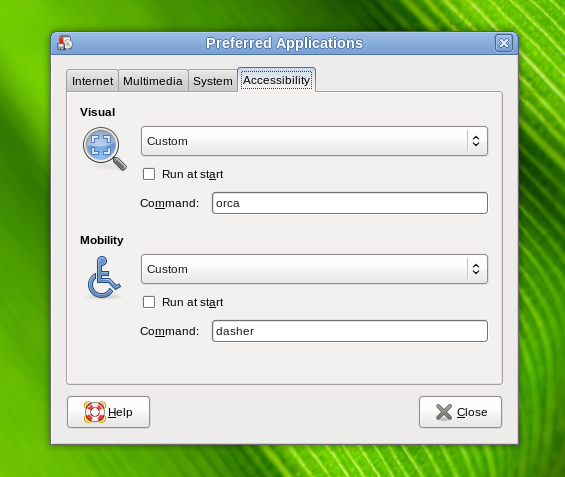
Wireless users may also welcome the new support for WPA encryption in the Network control panel.
2.11. Password Management
The GNOME Keyring system remembers your passwords for networked servers and web sites. In GNOME 2.20, the keyring is unlocked automatically when you login and when you unlock your screen, avoiding the need for an extra password prompt. Note, however, that this feature requires some work by your distribution. You can now also change your keyring's master password via the Encryption Preferences control panel, in the GNOME Keyring tab.
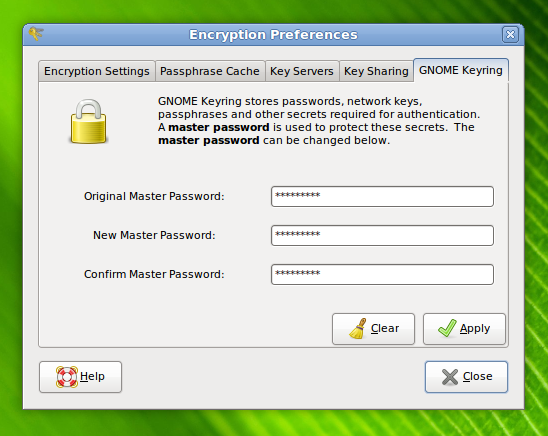
The Password and Encryption Keys utility now shows more notification details when you import keys, and allows you to choose the archive type when encrypting multiple files.
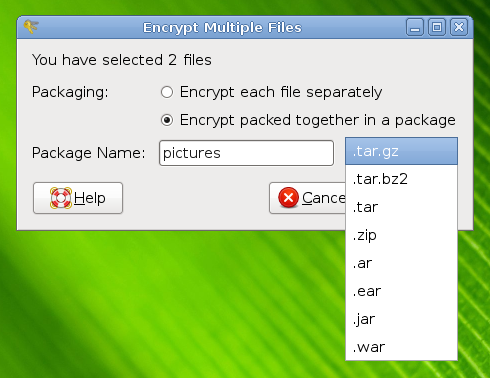
2.12. Help System
This release has seen some large changes in the infrastructure of the GNOME help browser (yelp), improving the style and layout. In addition, the colors now better match your current theme.
Help pages also now appear more quickly, as individual pages are now loaded on demand instead of the entire manual being parsed unnecessarily.
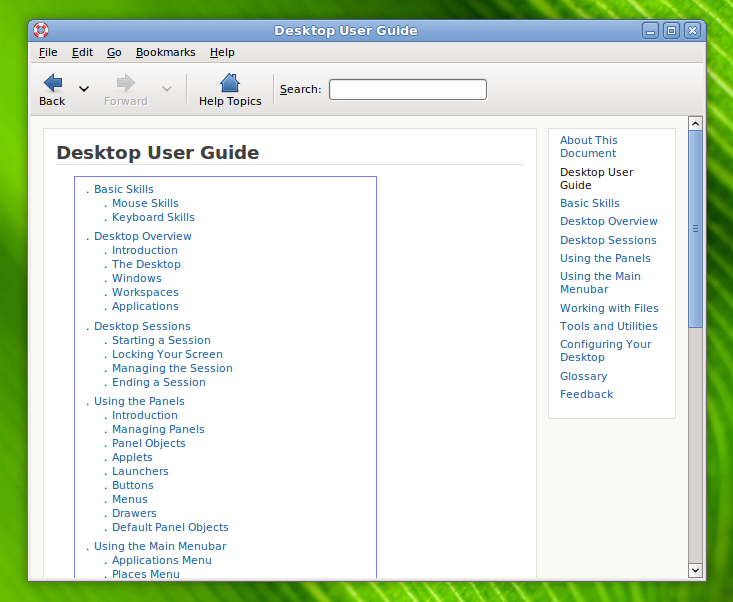
2.13. Power Management
GNOME's Power Manager now saves profile information about your batteries over time, to provide a far more accurate estimation of the time remaining, even with old worn-out batteries. It even knows about many battery models that have been recalled by their manufacturers.
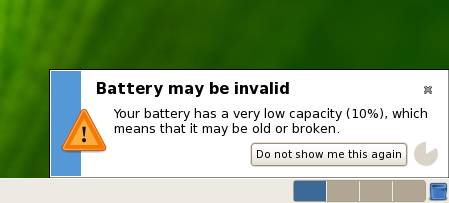
Several parts of GNOME, such as the volume mixer have also been corrected to remove unnecessary polling, resulting in power savings.
2.14. Login and Screensaver
Users could already choose their preferred language when logging in to GNOME, but now they can even see the login screen in their own language as soon as they choose it, thanks to an improved GDM (Gnome Display Manager).
The GNOME Screensaver now allows people to leave you a note while your screen is locked, by clicking the "Leave Message" button. You'll see these messages when you login.

2.15. Right-To-Left Languages
Languages such as Arabic and Hebrew are written from right to left. Users of these languages expect most user interface elements to be similarly mirrored, compared to left-to-right user interfaces. GNOME 2.20 improves the support in the following ways when using these languages:
- Window title buttons (such as minimize, maximize, and close) appear in mirrored order.
- Window title menu items are now aligned to the right.
- The alt-tab window switcher lists and moves through windows from right to left.
- The ctrl-alt-arrow workspace switcher lists and moves through workspaces from right to left,

2.16. Accessibility
GNOME's accessibility support can be customized to allow people with a range or disabilities to use GNOME. The Orca screen-reader is a key part of this support, using speech synthesis, braille, and magnification to assist people with visual impairments.
Orca's main advantage is its application-specific support. This means that it has an understanding of the specific user interaction models of particular applications in addition to the general meta-information available via the ATK toolkit (and the AT-SPI system). For instance, the latest version adds greatly improved support for OpenOffice, Firefox, Thunderbird, Pidgin (previously known as GAIM) and Java applications. It also now deals with progress bars, tooltips, and notification messages, and can use custom pronunciations for special words.
3. Шта је ново за администраторе
GNOME releases a collection of tools for systems administrators to help with large corporate deployments and situations where machine lockdown is required.
3.1. Lockdown and User Profile Editor
The "Sabayon" User Profile Editor allows administrators to set up user profiles inside a live, interactive GNOME session. When a profile is created or edited, a nested GNOME session is started up, which the administrator can use to change GConf defaults and mandatory keys in their own GNOME session.
Within the nested window a system administrator can create personalized profiles based on job description (e.g. receptionist, data entry clerk, programmer, human resources manager, etc.). These profiles can then be saved and deployed to various desktop machines with ease, saving the system administrator time. The profiles can also be modified and fine tuned as needed based on user feedback. Since they are in a centralized location they allow easy maintenance and deployment.
In GNOME 2.20 the User Profile Editor can also be used to set default preferences for OpenOffice applications in addition to the existing support for GNOME and Mozilla applications.

3.2. GDM (GNOME Display Manager)
GDM now has better utmp/wtmp auditing, so when users log in or log out entries are placed in /var/adm/utmp and /var/adm/wtmp. For instance, this allows programs such as who and finger to use the utmp database to get information about who is on the system. In addition, support for Linux auditing, via libaudit, logs the success or failure of each login attempt with the Linux kernel audit system.
GDM can also now use RBAC (Role Based Access Control) to control access to the Shutdown, Reboot, and Suspend features.
4. Шта је ново за програмере
The GNOME 2.20 Developers' Platform provides a stable base for independent software developers to create third-party applications. GNOME and its platform are licensed to allow the creation of both free and proprietary software to run on top of GNOME.
Јамчи се програмска и бинарна стабилност развојних библиотека за време док се објављују издања серије 2.x. Библиотеке окружења не потпадају под наведено јамство али у већини случајева су конзистентне од издања до издања.
- 4.1. GTK+
- 4.2. Glib
- 4.3. Pango
- 4.4. Glade
- 4.5. Accerciser
- 4.6. Developer Documentation
4.1. GTK+
GNOME 2.20 uses version 2.12 of the GTK+ UI toolkit API, which adds new features and important bug-fixes. The largest changes are:
A new GtkVolumeButton widget, for use by media players.
A new GtkRecentAction class to provide recent-files menu items.
An improved GtkTooltip API, which is much more convenient and powerful than the now-deprecated old GtkTooltips API. For instance, this allows tooltips in GtkTreeViews, and on insensitive widgets.
The new GtkBuilder API, which can build user interfaces from XML descriptions, intended to replace libglade soon.
- Support for some simple graphical effects, where the hardware and drivers support them, via functions such as gdk_window_set_composited() and gdk_window_set_opacity().
- New input methods for the Thai and Lao languages, plus a mobile-phone-style multipress input method for embedded devices.
- The built-in stock icons were updated to comply with the Tango freedesktop specification, so the appearance of GNOME applications is even more consistent with other toolkits and desktops.
The GtkFileChooser now shows the recent files list, and can be integrated with desktop search systems such as Beagle and Tracker, as mentioned above in the File Management section.
See also the list of new functions in GTK+ 2.12. Full details are in a series (see 1, 2, 3, 4) of emails from Matthias Clasen
4.2. Glib
The Glib utility library now has a g_get_user_special_dir() that provides the path to special folders defined by FreeDesktop.org's xdg-user-dirs specification and tool.
And for text processing, the new GRegex API provides regular expression string matching without the need for an additional library.
4.3. Pango
The Pango text rendering system has several improvements.
For instance, it has a new shaping engine for the N'Ko script used by the minority Mande languages in West Africa. These languages have not been well served by computer systems until now.

The improved OpenType Layout engine helps Pango to select the correct Glyph depending on the current language.

In addition, the new version of Pango has:
- Support for specifying multiple preferred languages.
- Vertical text shaping that uses vertical variants of punctuation marks.
- New pango_cairo functions, allowing simpler use of Pango with Cairo.
4.4. Glade
The Glade user interface designer is much improved, adding user interface and architectural improvements. For instance, tool windows, such as the editor, the inspector, and the palette, are now dockable.

And you can now right-click on widgets to conveniently make some of these changes:
- Add or remove the parent widget.
- Insert or remove a placeholder before or after the selected widget in a GtkBox.
- Insert or remove a page before or after the selected page in a GtkNotebook.
- Insert or remove a row or column in a GtkTable.
Library authors will be pleased to see that new widgets may be declared in the catalog without the need to write supporting source code, allowing developers to use your extra widgets in Glade.
4.5. Accerciser
The new accerciser Accessibility Explorer allows you to check whether your application provides the information needed by accessibility tools such as GNOME's Orca screenreader.

4.6. Developer Documentation
GNOME's new documentation website, library.gnome.org, lists all the latest tutorials, manuals and API references. It's the result of a Google Summer Of Code project which ensures that the online documentation stays up-to-date, even showing several versions of the same documents, in multiple languages too.
This includes the new Overview of the GNOME Platform document, which is now an official part of GNOME's software releases, in the gnome-devel-docs module. It's a good place for new GNOME developers to start.
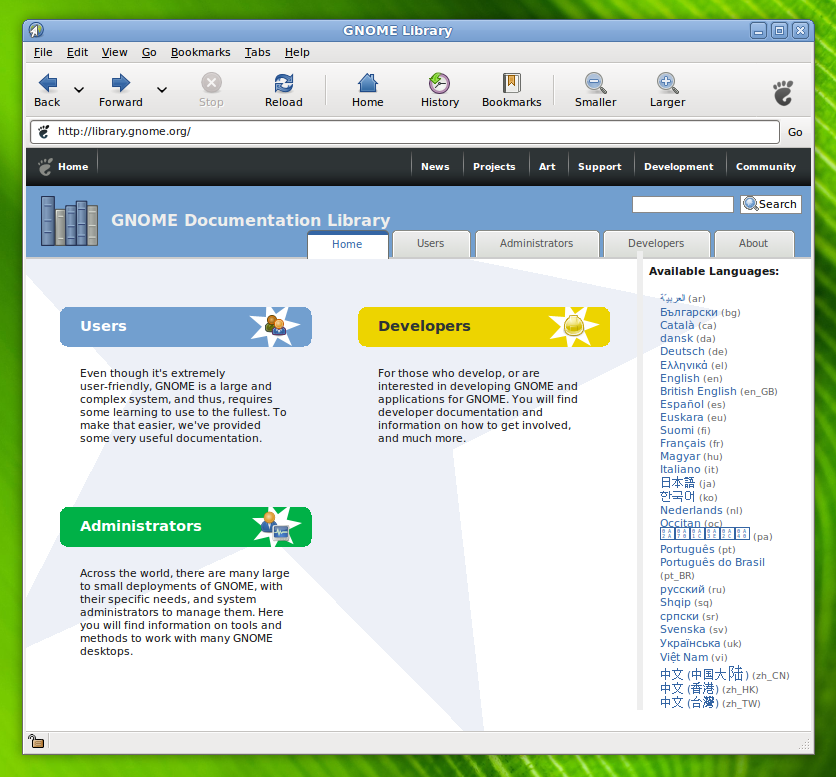
For offline documentation, we strongly encourage the use of the DevHelp utility, particularly when searching for function or class names, though you must remember to install the relevant documentation packages from your distribution. DevHelp is also now part of GNOME's official Developer Tools release.
5. Интернационализација
Thanks to members of the worldwide GNOME Translation Project, GNOME 2.20 offers support for 48 languages (at least 80 percent of strings translated), including the user and administration manuals for many languages.
Подржани језици:
- Albanian
- Arabic
- Basque
- Bengali (India)
- Bulgarian
- Brazilian Portuguese
- Catalan
- Chinese (China)
- Chinese (Taiwan)
- кинески (Хонг Конг)
- Czech
- Danish
- Dzongkha
- Dutch
- English
- Estonian
- Finnish
- French
- Galician
- German
- Greek
- Gujarati
- Hindi
- Hungarian
- Indonesian
- Italian
- Japanese
- Korean
- Latvian
- Lithuanian
- Macedonian
- Malayalam
- Norwegian Bokmål
- Polish
- Portuguese
- Punjabi
- Romanian
- Russian
- Serbian
- Serbian Latin
- Spanish
- Slovenian
- Swedish
- Tamil
- Thai
- Turkish
- Ukrainian
- Vietnamese
- Welsh
Бројни други језици су делимично подржани, са више од пола преведених порука. За превод Гнома 2.14 на српски језик је био задужен Слободан Д. Средојевић.
6. Инсталација Гнома 2.14
You can try out GNOME 2.20 via the LiveCD which contains all of the software included in GNOME 2.20 on a single CD. It can be downloaded from the GNOME BitTorrent site.
To install or upgrade your machine to GNOME 2.20, we recommend you install official packages from your vendor or distribution. Popular distributions will make GNOME 2.20 available very soon and some already have development versions with GNOME 2.20 available. You can get a list of distributions who ship GNOME, and discover the latest versions they ship on our Get Footware page.
If you are brave and patient and would like to build GNOME from source, we recommend you use one of the build tools. GARNOME builds GNOME from release tarballs. You will need GARNOME 2.20.x to build GNOME 2.20.x. There is also jhbuild which is designed to build the latest GNOME from svn. You can also use jhbuild to build GNOME 2.20.x by using the gnome-2.20 moduleset.
For those who really want to compile the entire desktop by hand, the order to compile the modules in is: libxml2, libgpg-error, libgcrypt, libxslt, gnome-common, intltool, rarian, gtk-doc, glib, libIDL, ORBit2, fontconfig, cairo, pango, gnome-doc-utils, atk, shared-mime-info, gtk+, gconf, libbonobo, gail, at-spi, gnome-mime-data, desktop-file-utils, libdaemon, dbus, dbus-glib, dbus-python, pygobject, pycairo, libglade, pygtk, avahi, libvolume_id, hal, gamin, gnome-vfs, audiofile, esound, libart_lgpl, libgnome, libgnomecanvas, libbonoboui, hicolor-icon-theme, icon-naming-utils, gnome-icon-theme, gnome-keyring, libgnomeui, gnome-menus, alacarte, libtasn1, opencdk, gnutls, libsoup, mozilla, evolution-data-server, libgtop, startup-notification, gtk-engines, gnome-themes, gnome-desktop, bug-buddy, metacity, libgsf, libcroco, libgnomecups, libgnomeprint, libgnomeprintui, librsvg, eel, nautilus, libxklavier, libgnomekbd, gstreamer, liboil, gst-plugins-base, libwnck, gnome-panel, gnome-control-center, gnome-speech, dasher, pyorbit, gnome-python, gtksourceview-1.0, nautilus-cd-burner, gst-plugins-good, libmusicbrainz, iso-codes, totem, gnome-media, gnome-python-desktop, deskbar-applet, pwlib, opal, ekiga, eog, enchant, epiphany, poppler, evince, gtkhtml, evolution, evolution-exchange, evolution-webcal, fast-user-switch-applet, file-roller, gcalctool, gconf-editor, gdm2, gtksourceview, pygtksourceview, gedit, gucharmap, system-tools-backends, gnome-applets, gnome-backgrounds, gnome-games, gnome-keyring-manager, gnome-netstatus, gnome-nettool, libcolorblind, gnome-mag, gnome-power-manager, gnome-screensaver, gnome-session, libsigc++2, glibmm, cairomm, gtkmm, gnome-system-monitor, liboobs, gnome-system-tools, vte, gnome-terminal, gnome-user-docs, gnome-utils, gnome-volume-manager, gok, libgail-gnome, orca, seahorse, sound-juicer, tomboy, vino, yelp, zenity, pessulus, sabayon, devhelp, glade3, accerciser, gnome-devel-docs
This list is provided purely for reference and we strongly urge anyone trying to compile GNOME from source to consider using one of the build tools listed above.
7. Looking Forward to GNOME 2.22
Naturally, development doesn't stop with GNOME 2.20. Six months from the day that GNOME 2.20 is released GNOME 2.22 will follow and build on the base of its predecessor.
Things to look forward to in GNOME 2.22 should include:
- A major new version of GNOME's Ekiga VoIP client with a revamped user interface and SIP presence support.
- More consolidation of control panel applets by merging them together.
- Simpler arrangement of panel applets, with an improved API for developers.
- A reworked user interface for the Sabayon User Profile editor.
- Availability of a new virtual filesystem API, used by the Nautilus File Manager.
GNOME's roadmap details the developers' plans for the next release cycle, and the GNOME 2.22 release schedule will appear soon.
8. Заслуге
These release notes were compiled by Murray Cumming, Jorge Castro and Andreas Nilsson with extensive help from the GNOME community. On behalf of the community, we give our warmest thanks to the developers and contributors who made this GNOME release possible.
Дозвољено је превођење овог рада на било који језик. Ако желите да обавите превод на ваш језик, молим обратите се координатору вашег преводилачког тима: Подухват превођења Гнома.
